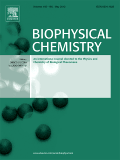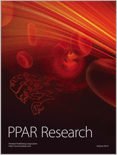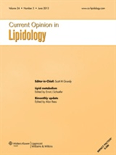
BIOCHIMICA ET BIOPHYSICA ACTA-MOLECULAR AND CELL BIOLOGY OF LIPIDS
Scope & Guideline
Connecting Scholars in Lipid Science
Introduction
Aims and Scopes
- Lipid Metabolism and Homeostasis:
Research articles often explore the pathways and regulatory mechanisms of lipid metabolism in various organisms, emphasizing the balance of lipids in health and disease. - Lipid-Disease Associations:
The journal frequently publishes studies that investigate the correlation between lipid profiles and diseases such as obesity, diabetes, cardiovascular diseases, and cancer, highlighting the clinical relevance of lipid research. - Lipidomics and Analytical Techniques:
Papers often focus on novel lipidomic techniques and methodologies, enhancing the understanding of lipid composition and dynamics in biological samples. - Molecular Mechanisms of Lipid Action:
The journal covers research on the molecular interactions and signaling pathways involving lipids, including their roles in cell signaling, membrane dynamics, and energy storage. - Role of Lipids in Cell Function:
Research highlights the impact of lipids on cellular processes such as inflammation, apoptosis, and cell differentiation, providing insights into their physiological and pathological roles.
Trending and Emerging
- Lipid Signaling in Inflammation:
There is an increasing focus on the role of lipids in inflammatory processes, particularly how lipid mediators influence immune responses and contribute to chronic diseases. - Metabolomics and Systems Biology Approaches:
Emerging studies are utilizing advanced metabolomics and systems biology techniques to provide comprehensive insights into lipid metabolism and its interactions with other metabolic pathways. - Therapeutic Potential of Lipids:
Research is trending towards exploring the therapeutic applications of lipids, including their roles in drug delivery systems and as potential treatments for various diseases. - Microbiome and Lipid Interactions:
An emerging theme highlights the relationship between the gut microbiome and lipid metabolism, focusing on how microbial communities influence lipid profiles and metabolic health. - Role of Extracellular Vesicles in Lipid Transport:
There is growing interest in the function of extracellular vesicles in lipid transport and signaling, shedding light on their role in intercellular communication and disease progression.
Declining or Waning
- Plant Lipid Metabolism:
Research focusing on lipid metabolism in plant systems has seen a decline, with fewer studies published on plant-specific lipid biosynthesis and function compared to previous years. - Basic Biochemical Pathways:
There has been a noticeable reduction in studies that solely focus on basic lipid biochemical pathways without exploring their implications for health and disease, as the journal's emphasis has shifted towards more applied research. - Historical Perspectives on Lipid Research:
The journal has moved away from publishing historical reviews or perspectives on lipid research, favoring contemporary studies that address current challenges and innovations in lipid biology.
Similar Journals

JOURNAL OF MEMBRANE BIOLOGY
Exploring the Intricacies of Membrane DynamicsWelcome to the Journal of Membrane Biology, a premier publication dedicated to advancing our understanding of the complex roles membranes play in biological systems. Published by Springer, this journal features research articles, reviews, and communications on a broad range of topics related to membrane biology, including biomolecular interactions, transport mechanisms, and physiological responses. With an ISSN of 0022-2631 and E-ISSN 1432-1424, the journal has been a cornerstone in the field since its inception in 1969 and continues to thrive as it looks towards 2024. Ranked in the second quartile (Q2) for Biophysics and Physiology, and third quartile (Q3) in Cell Biology, it showcases impactful research that embodies the spirit of scientific inquiry and innovation. Although currently not an Open Access journal, it remains easily accessible to researchers, professionals, and students eager to delve into the dynamic world of membrane studies. As the understanding of membrane dynamics expands, so does its relevance in areas such as drug development and cellular engineering, making the Journal of Membrane Biology an essential resource for those at the forefront of these critical scientific advancements.

BIOLOGICHESKIE MEMBRANY
Illuminating the Pathways of Biological DiscoveryBIOLOGICHESKIE MEMBRANY is a critical journal in the field of Cell Biology and Molecular Biology, published by MEZHDUNARODNAYA KNIGA in the Russian Federation. With an ISSN of 0233-4755, this journal has been serving the academic community since 1996 and continues to publish cutting-edge research that advances our understanding of biological membranes and their functions. Despite being classified in Q4 quartiles for both Cell and Molecular Biology in the 2023 category rankings, the journal presents a unique platform for emerging research within these pivotal areas. Researchers, professionals, and students alike will find valuable insights in its pages as it seeks to foster a collaborative environment that encourages knowledge sharing. Although currently not available as an open-access journal, it remains an essential resource for those looking to deepen their knowledge and contribute to ongoing discussions in the biological sciences. The journal’s commitment to publishing quality research is underscored by its continuous coverage until 2024, making it a sustained reference in the field.

BIOPHYSICAL CHEMISTRY
Connecting disciplines to illuminate the science of life.BIOPHYSICAL CHEMISTRY, published by Elsevier, is a prestigious journal with a long-standing tradition since its inception in 1973. This highly respected journal focuses on the intersections of biochemistry, biophysics, and organic chemistry, providing a critical platform for researchers, professionals, and students to disseminate pivotal findings in these dynamic fields. With an impressive impact factor that reflects its robust academic influence and high citation rates, it ranks within the Q2 quartile among its peers in multiple categories, indicating its significance in the scholarly community. The journal, hosted in the Netherlands, encompasses a diverse range of topics, from molecular interactions to protein folding, and serves as an essential resource for those engaged in cutting-edge research. Researchers looking to share their work with a global audience will find BIOPHYSICAL CHEMISTRY an invaluable outlet, fostering the advancement of knowledge in this crucial area of science. For more information, visit the journal's page on the Elsevier platform.

FEBS Journal
Connecting Researchers to Transformative DiscoveriesFEBS Journal is a prestigious, peer-reviewed publication dedicated to advancing the field of biochemistry, cell biology, and molecular biology. Published by WILEY in the United Kingdom, this journal boasts an impressive impact factor and ranks in the top quartile (Q1) across multiple relevant categories, including Biochemistry, Cell Biology, and Molecular Biology, reflecting its significant contribution to scientific research. With an ISSN of 1742-464X and an E-ISSN of 1742-4658, the FEBS Journal publishes original research and comprehensive reviews that push the boundaries of knowledge and innovation in the biosciences. As a vital resource for researchers, professionals, and students alike, the journal offers Open Access options, ensuring that cutting-edge discoveries are accessible to a broad audience. With a publication history converging from 2005 to the present and a robust emphasis on high-quality scholarly work, the FEBS Journal remains an essential platform for the dissemination of significant findings and advancements in the life sciences.

JOURNAL OF CELL SCIENCE
Transforming knowledge in cellular innovation.JOURNAL OF CELL SCIENCE, with ISSN 0021-9533 and E-ISSN 1477-9137, is a distinguished publication in the field of Cell Biology, released by COMPANY BIOLOGISTS LTD in the United Kingdom. Since its inception in 1966, this journal has served as a vital platform for disseminating cutting-edge research and reviews that significantly advance our understanding of cellular processes and innovations. Currently positioned in the Q1 category within the 2023 rankings, this journal is recognized for its high impact and quality, holding a notable Scopus rank of 120 out of 285 in the Cell Biology category, placing it within the 58th percentile. While not an open-access journal, it provides extensive access options for readers and institutions, ensuring that pivotal research is accessible to a wide audience. With converged publication years leading toward 2024, JOURNAL OF CELL SCIENCE continues to be an essential resource for researchers, professionals, and students alike, fostering a deeper understanding of the intricate workings of cell biology.

DEVELOPMENTAL CELL
Pioneering Research in Cell and Developmental BiologyDEVELOPMENTAL CELL, published by CELL PRESS, stands as a premier journal in the fields of Biochemistry, Genetics and Molecular Biology, Cell Biology, and Developmental Biology. With a significant influence evidenced by its Q1 rankings across several categories in 2023 and a remarkable Scopus ranking placing it at the 98th percentile for Developmental Biology, this journal is pivotal for researchers and academics aiming to advance their understanding of cellular processes. Covering a broad range of topics from molecular mechanisms to cellular developmental pathways, DEVELOPMENTAL CELL publishes cutting-edge research articles that contribute to the dynamic landscape of cell biology and related disciplines. Although it does not currently offer open access, the journal is accessible through institutional subscriptions, reinforcing its commitment to disseminating high-quality scientific knowledge produced by leading experts in the field. Based in the United States, DEVELOPMENTAL CELL continues to push the boundaries of discovery and innovation in life sciences, making it an essential resource for professionals, researchers, and students alike in the quest for foundational biological insights.

DEVELOPMENTAL BIOLOGY
Driving Innovation in Developmental BiologyDEVELOPMENTAL BIOLOGY, published by Academic Press Inc., Elsevier Science, stands as a pivotal journal in the fields of cell biology, developmental biology, and molecular biology since its inception in 1959. Renowned for its rigorous peer-review process, this journal serves as a platform for publishing cutting-edge research, reviews, and insights that drive forward our understanding of developmental processes at the cellular and molecular levels. With an impressive track record, it is classified in the Q2 quartile across multiple categories, reflecting its significant impact and relevance in academia and research communities. Although the journal does not provide Open Access options, it remains accessible via numerous academic databases, ensuring a wide reach for researchers, professionals, and students alike. With a commitment to advancing the field, DEVELOPMENTAL BIOLOGY continues to be essential reading for those looking to stay at the forefront of developmental research and its applications.

PPAR Research
Championing Open Access in PPAR ResearchPPAR Research, an esteemed journal published by HINDAWI LTD, specializes in the rapidly evolving fields of drug discovery and pharmacology, contributing significantly to the body of research surrounding peroxisome proliferator-activated receptors (PPARs) and their roles in various biochemical processes. With an open access policy implemented since 2006, the journal ensures that its high-quality content is readily available, promoting widespread dissemination of knowledge. Currently ranked in the Q2 category for both Drug Discovery and Medical Pharmacology, it boasts a respectable position within the scientific community, evidenced by its Scopus rankings. PPAR Research serves as an essential resource for researchers, professionals, and students looking to advance their understanding of PPAR biology and its implications in therapeutic development. The journal's commitment to excellence and accessibility makes it a key player in supporting innovative research and critical discussions in the life sciences.

CURRENT OPINION IN LIPIDOLOGY
Exploring the forefront of lipid science.Current Opinion in Lipidology is a premier journal published by Lippincott Williams & Wilkins, offering critical insights into the ever-evolving landscape of lipid research. With an impressive convergence spanning from 1990 to 2024, this journal serves as an essential platform for researchers, clinicians, and professionals dedicated to the study of lipids in relation to cardiovascular health, endocrinology, and metabolism. The journal currently holds a distinguished Q1 ranking in Cardiology and Cardiovascular Medicine, Endocrinology, Diabetes and Metabolism, and Nutrition and Dietetics, showcasing its significant impact in these fields. Additionally, it ranks in the Q2 quartile for Cell Biology and Molecular Biology, underlining its comprehensive approach to lipidology. Though not open access, the content is rich with cutting-edge reviews, clinical studies, and expert opinions that aim to advance knowledge and practice in lipid metabolism, making it a valuable resource for anyone seeking to stay abreast of the latest developments in lipid research.

ARTERIOSCLEROSIS THROMBOSIS AND VASCULAR BIOLOGY
Exploring the frontiers of cardiovascular medicine and innovation.ARTERIOSCLEROSIS THROMBOSIS AND VASCULAR BIOLOGY, published by Lippincott Williams & Wilkins, is a leading journal in the field of cardiovascular medicine, dedicated to the advancement of research surrounding arterial diseases, thrombosis, and vascular biology. With an impressive impact factor indicative of its reach and influence, this journal occupies a prominent position in the Q1 category of cardiology, ranking 13th out of 387 in its field according to Scopus, placing it within the top 96th percentile among cardiovascular research journals. Since its inception in 1990, ARTERIOSCLEROSIS THROMBOSIS AND VASCULAR BIOLOGY has been pivotal in disseminating cutting-edge research that drives innovation and education in cardiovascular health. Although it does not operate under an open access model, the journal is a vital resource for researchers, clinicians, and students looking for high-quality, peer-reviewed articles that contribute to the understanding and treatment of cardiovascular and vascular disorders. Its commitment to rigorous scientific standards and its focus on impactful findings make it an essential publication for anyone dedicated to the field.